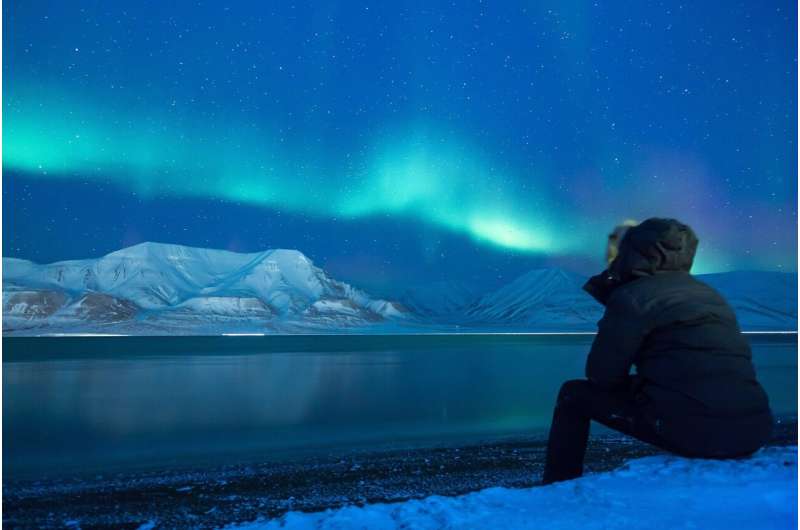This article has been reviewed according to Science X's editorial process and policies. Editors have highlighted the following attributes while ensuring the content's credibility:
fact-checked
peer-reviewed publication
trusted source
proofread
Protecting delicate polar ecosystems by mapping biodiversity

Polar regions contain vast, undiscovered biodiversity but are both the most threatened and least-understood areas of the world.
Now scientists led by the University of East Anglia (UEA) and the British Antarctic Survey (BAS) are calling for a roadmap of polar ecosystems to fill that knowledge gap, preserve polar life and even protect "our everyday life and our planet's health." The study would map all biodiversity in those regions, from the atmosphere to the deep sea and from land to the oceans.
The authors said concerted action is required to mitigate the impact of warming on polar ecosystems via conservation efforts, to sustainably manage these unique habitats and their ecosystem services, and for the sustainable bioprospecting of novel genes and compounds for societal gain.
"Multi-omics for studying and understanding polar life," is published in Nature Communications. The paper is co-authored by UEA, BAS, and the University of Bielefeld, Germany.
Polar ecosystems are the most threatened because they are the most sensitive to global warming. They are being lost at a rapid pace, and with them, all the biology that provides ecosystem services and biology-driven regulation of the climate, including the carbon cycle.
Prof Thomas Mock, Professor of Marine Microbiology in UEA's School of Environmental Sciences, is the joint lead author with Prof Melody Clark, Project Leader for the British Antarctic Survey.
Prof Thomas Mock said, "Biodiversity projections for the polar regions can only be reliably constructed if we have a sufficiently profound understanding of the diversity, ecological functions, and interrelations of polar organisms, as well as their resilience to climate change."
"These remote regions play substantial, often underappreciated, roles in the carbon cycle and drive global nutrient and dissolved organic matter fluxes. Consequently, polar environmental and ecological processes are intimately connected with our everyday life and our planet's health, much of which is underpinned by the endemic biota, from viruses to large animals."
"There is strong evidence that climate-induced changes in the polar regions are already altering species distributions on land and in the sea, with major impacts on ecosystem function."
Some species have shifted poleward, which has a knock-on effect on the food chain. Polar life, from microbes to seals, whales, and polar bears, largely depends on overall low temperatures and a substantial snow and ice cover, which are experiencing the impacts of global warming.
In the Arctic, temperatures are rising at least four times faster than elsewhere, destabilizing the Arctic jet stream and increasing the likelihood of extreme weather events, including heat waves, drought, and flooding in temperate regions.
On land, permafrost melting and collapsing Arctic coastlines are dramatically altering ecological interactions and biogeochemistry due to the release of millennia-old carbon stores, trace elements, nutrients, and potentially even deep-frozen ancient viruses and pathogenic bacteria.
In the oceans, the increased seasonal melting of sea ice is stabilizing surface waters too much, which reduces the amount of nutrients required for primary production to take place.
Similarly, the situation in the Southern Ocean and Antarctic continent is equally bleak, particularly for the Antarctic Peninsula, which has already experienced substantial levels of warming that has increased the loss of sea ice and glaciers.
The Southern Ocean is responsible for the uptake of three-quarters of the anthropogenic heat absorbed by the ocean and up to half of the carbon drawdown. It accounts for around 40% of the global oceanic uptake of anthropogenic CO2 and around 50% of the total atmospheric uptake. Furthermore, sequestering carbon by the organisms living in polar seas is probably the largest natural negative feedback against climate change.
The climate impacts on biodiversity and ecosystem functioning in both the Arctic and Antarctic serve as a bellwether for the consequences of global warming, including the persistence of biodiversity on Earth.
Prof Clark said, "Sequencing technologies have massively changed our abilities to decipher how organisms work. However, the uptake in polar biology has been relatively low, especially when considering the tens of thousands of species that reside at the poles and are at threat in our warming world.
"Understanding how lots of very strange organisms live in extreme cold can help answer global questions and provide real benefits for society. Failure to act now will result in a substantial loss of knowledge regarding evolutionary adaptation to the cold."
Genomic screening not only offers the possibility of identifying populations under stress but it can also be used for the monitoring of invasive species, thereby facilitating early interventions.
Prof Mock said, "With the cold regions of our planet diminishing, there is a real imperative to obtain full genome sequences for diverse organisms inhabiting polar ecosystems, from the deep oceans to the permafrost on land, for both the Arctic and Antarctic. This will enable the wider application of omics technologies to polar species, which will revolutionize our understanding of evolution in the cold and adaptive responses to a warming world."
More information: M. S. Clark et al, Multi-omics for studying and understanding polar life, Nature Communications (2023). DOI: 10.1038/s41467-023-43209-y
Journal information: Nature Communications
Provided by University of East Anglia

















